Fly Tying
now browsing by category
Posted by: Warren Prior | on October 14, 2012
Coleford Limey
Coleford Limey |
|
This fly is a Peter Briggs Creation which he first tied and fished at Coleford in 1992. It proved so successful that it attained almost legendary status as a taker of trout with his angling companions. Peter in the true spirit of a fly fisherman shared the recipe and creation of this fly with us at the October 2002 meeting of the Durban Fly Tyers. |
|
|
|
|
Materials |
|
| Hook | Nymph #12 to #16 2x or 3x |
| Thread | Black |
| Tail | A small bunch of black Hackle |
| Body | Lime or Olive Green Marabou |
| Rib | Fine Copper Wire |
| Hackle | Black or Reddish Brown |
| Weight | Lead wire if Required Brass Bead if preferred |
Tying Instructions |
|
| Dress the hook with thread to a point opposite the barb. Tie in a small bunch of Black Hackle fibers and the ribbing at the same point.Strip a bunch of marabou fibers from the quill and tie in by the points, Wind the thread up to near the eye of the hook.Twist the marabou fibers into a rope an wind forward in touching turns to form the body. Stroke the fibers back between each turn. Tie off allowing space for the hackle and head. Trim excess marabou.
Bring the ribbing forward in 3-4 even turns (opposite direction to body) making sure you do not trap the marabou fibers. Tie off and trim. Tie in the hackle by the tip and wind forward in 4 even turns stroking back between turns. Tie off and trim just behind the eye. When forming the head pull the hackle fibers back and trap at the base with a few loose turns. The hackle fibers must lie back over the body. Finish the head neatly. Tie off and varnish. |
|
Posted in Fly Tying, Fresh Water Fly, Trout | No Comments »
Posted by: Warren Prior | on October 14, 2012
Elk Hair Caddis Variation
Elk Hair Caddis Variation |
|
The Elk Hair Caddis Variation is a favourite of mine both for rivers and still waters. It can be fished as an adult caddis imitation or even a small hopper at times. Size can vary from #12 for still waters mainly down to size #18 for small streams. I think the optimal sizes are #14 and #16. It floats well and can be easily seen on the water. Although it floats fairly low in the surface film, like the natural caddis it can be skated easily across the water. |
|
|
|
|
Materials |
|
| Hook | Traditional straight shank hook with wide gape |
| Thread | Black |
| Tail | Deer hair |
| Body | Peacock herl. (Experiment with other colours of dubbing.) |
| Wing | Deer Hair |
| Hackle | Grizzly or Badger |
Tying Instructions |
|
| 1) Tie in tying thread and wrap in touching turns to a point opposite the barb.
2) Tie in a short sparse bunch of deer hair as the tail. Take 2 loose turns around the shank and deer hair and then two tight turns next to this on the eye side of the hook to prevent flaring of the tail. 3) Add peacock herl o dubbing o choice to create the abdomen/thorax finishing at a point 2/3 the way back along the shank and secure. 4) Add the deer hair wing at the point you finished the abdomen, sloping it over the back with the tips finishing just short of the ends of the tail. Take two loose turns of thread around the shank and deer hair and then two tight turns next to this on the eye side of the hook to prevent flaring of the wing. Try and prevent the wing from lifting two high off the shank. Ideally it should lie across the top of the abdomen. 5) Tie in a hackle as you would for a dry fly, with fibres about width of the gape. 6) Wind the hackle forward in a few turns keeping it sparse, and secure behind the eye, leaving enough space to create a neat small head. 7) Finish the head with tying thread, whip finish and apply varnish. |
|
Posted in Fly Tying, Fresh Water Fly, Trout | No Comments »
Posted by: Warren Prior | on October 14, 2012
Crazy Charlie
Crazy Charlie |
|
Although an easy fly to tie, it is often discounted and sits indefinitely in one’s fly box. Take them out, dust them off and even tie more. |
|
|
|
|
Materials |
|
| Hook | # 4 or 6 (stainless steel) |
| Thread | Personal preference |
| Tail | Calf tail / slinky fibre (a good pinch of)
Chrystal flash 2/4 strands |
| Body | Flashabou / Gliss n Glow and monofilament 7 to 10 kg |
| Eyes | Bead chain / Dumbell |
Tying Instructions |
|
| 1. Dress hook, tie in eyes behind hook eye allowing enough space to tie in the wing and flash.2. Tie in a length of monofilament and two or three strands of flashabou or Gliss n Glo of a colour of your choice at the bend above the barb.
3. Wrap the flash forward to between eyes and secure. Wrap the monofilament over the flash in the same way and tie off. 4. Tie in the wing allowing it to extend past the bend by 5 to 10 mm. Tie in the flash on top of wing. This recipe is for a standard / traditional type Charlie. When tying these, your only limitation is your imagination. |
|
Posted in Fly Tying, Salt Water Fly | No Comments »
Posted by: Warren Prior | on October 14, 2012
Tiger Bugger
Tiger Bugger |
|
This fly imitates a small bait fish (including juvenile tigers), and is viciously attacked by the larger tiger fish due to the territorial and aggressive nature of the tiger fish, especially in rapids. |
|
|
|
|
Materials |
|
| Hook | Kamasan (Deep Water Salmon) #2 or Mustad SS 34011 #4 |
| Thread | Black 3/0 |
| Tail | Marabou (white, orange, red); Crystal Flash (silver, pearl) |
| Body | Mylar tubing / minnow body (pearl, silver); saddle hackle (white) |
| Eyes | Nymph bead |
Tying Instructions |
|
| 1. Position nymph bead on hook against hook eye.
2. Dress hook with thread and position over barb of hook. 3. Tie in the tail (1/3 length of hook). 4. Build up body to suit minnow tubing diameter, starting at the base of the tail and ending at the nymph bead head. 5. Slip minnow body / mylar tubing over cylindrical body and tie behind head and at the base of the tail. 6. Tie in saddle hackle at base of tail and palmer wind forward and tie off behind bead head. 7. Super glue base of tail and behind bead head. |
|
Posted in Fly Tying, Fresh Water Fly, Tigerfish | No Comments »
Posted by: Warren Prior | on October 14, 2012
Bass Muddler
Bass Muddler |
|
Due to the wind resistance of the pattern at least a 5/6 weight rod is required. Cast in the direction of the bank (as close as possible) or structure, allow to settle for a few seconds then give a a few rapid short strips interspersed with pauses of a few seconds. Continue to strip until over the drop off and the repeat the sequence gradually covering all the water in front of you. The idea is to create sufficient disturbance to test the agression of the bass. By the way many a wary trout has been caught in the shallows in the early morning and late evenings on windy/stormy days. |
|
|
|
|
Materials |
|
| Hook | SS Size #4 long Shank |
| Thread | 3/0 Mono Colour to match |
| Underbody | White or Black Foam (optional) |
| Overbody | Fluorescent Fritz or Chenille (Crystal) |
| Wing | Deer Hair topped with Marabou and Peacock Herl |
| Collar | Spun Deer Hair |
| Head | Spun deer hair clipped to shape |
| Tail | Marabou or Bucktail (red orange chartreuse) |
Tying Instructions |
|
| 1. Start thread above barb of hook and tie in flat section of foam.2. Tie in the tail (1/3 length of hook shank) and fritz. Wind the thread forward to about 1/3 the shank length from the eye.3. Wrap the foam in overlapping turns toward the hook eye and tie it off when the end of the thread is reached.
4. Wind the fritz forward over the foam and tie off at the same point. 5. Stack a clump of deer hair in a stacker and tie in directly in front of the Fritz on top of the hook. The tips should extend to the bend in the hook. 6. Tie in a small bunch of marabou directly over the deer hair (colour of choice) and 4-5 Peacock Herls directly on top of that. 7. Stack a thick clump of deer hair in the stacker and spin a collar around the hook shank. 8. Repeat the above step (stacking no longer required) over and over until the front third of the shank is covered. make sure to pack the hair tightly back after each application. 9. Tie off the thread behind the hook eye and apply a drop of head cement, then shape the head with scissors or a sharp rasor blade. The larger the head and collar the better the pattern will float. Note: The collar particularly the bottom provides most of the buoyancy to the fly. Clipping the bottom close to the hook shank results in a loss of buoyancy thus allowing the fly to fish sub surface. The foam in this type of application should also be omitted. |
|
Posted in Bass, Fly Tying, Fresh Water Fly | No Comments »
Posted by: Warren Prior | on October 14, 2012
Lefty’s Deceiver
Lefty’s Deceiver |
|
Lefty Cray originally tied this fly and it’s more a style of tying than a particular pattern.This fly can be tied to imitate just about any small fish and if fished slowly it can also resemble a squid. It is an internationally recognized fish catcher both off shore and for land based fly fishers.South African fly fishermen hold it in high esteem for both fresh water species such as Tiger Fish and countless salt-water species. For me this fly has resulted in my biggest Shad as well as Kingie.If there are fish around and you just can’t seem to connect, try a Deceiver. It’s also a good low light or dirty water fly because it pushes a lot of Water. |
|
|
|
|
Materials |
|
| Hook | SS Size #2-#8/0 |
| Thread | White 3/0 |
| Tail | Saddle hackle |
| Body | Sparkle dubbing or cactus chenille |
| Eyes | Dolls eyes or stick on eyes |
| Over Wing | Buck tail of a darker shade than under wing and peacock herl |
| Under Wing | Buck tail of lighter shade than over wing, flash maybe used |
| Flash | Colour to match |
Tying Instructions |
|
| 1. Take the tread and position it above the barb of the hook and tie in flash, which should extend a little beyond the saddle hackle. Then tie in saddle hackle. The hackle can face in or out, your choice2. Dress the shank with chenille or dubbing, remember to leave space for the head3. Tie in some buck tail in a series of layers (depending how sparse you want the fly to be) on the top of the hook and below creating a flat wide profile Flash can be added in between buck tail.
4. Cut the buck tail at a taper to build up head and stack next layer The top layers should extend to the middle of the saddle hackle and on the under be the length of the shank. 5.Flash can be tied in on the under side to create belly shine or red hackle fibre to give the impression of the Gills 6. Six strand of Peacock herl on top can add a touch of class 7. Nail polish can be used to colour the head before applying Epoxy. 8.Doll eyes can be stuck on behind the head or stick on eyes can be stuck on the head itself. |
|
Posted in Fly Tying, Salt Water Fly | No Comments »
Posted by: Warren Prior | on October 14, 2012
DDD
DDD |
|
Tom Sutcliffe is the originator of this fly which was named after Bill Duckworth who had considerable success fishing this fly in the Dargle area. Hence the name Duckworth’s Dargle Delight. |
|
|
|
|
Materials |
|
| Hook | Dry #12 to #16 2x |
| Thread | Black |
| Tail | Deer Hair |
| Body | Spun Deer Hair |
| Hackle | Ginger Cock |
Tying Instructions |
|
| Take a small clump of Deer hair and tie in a tail.Take a larger clump of Deer hair remove fluff and spin just ahead of the tail.
Repeat this step 3 to 4 times leaving enough room for the hackle and head. Remove from the vice and trim the deer hair to a cone shape. Make sure to trim very short under the hook shaft to expose the gape of the hook. Tie in the hackle by the base and wind forward in 4 even turns stroking back between turns. Tie off and trim just behind the eye. When forming the head pull the hackle fibers back and trap at the base with a few loose turns. The hackle fibers must lie back against the body. Finish the head neatly. Tie off and varnish. |
|
Posted in Fly Tying, Fresh Water Fly, Trout | No Comments »
Posted by: Warren Prior | on October 14, 2012
Salty Bugger
Salty Bugger |
|
A very simple and easy fly to tie, but very effective. This fly has already landed over 20 species (salt) for Hoosen. |
|
|
|
|
Materials |
|
| Hook | No 4 or 6 |
| Weight | Optional – add few turns of lead wire |
| Tail | Maribou (white) + Krystal flash (pearl) |
| Body | Slf dubbing / dubbing brush / tinsel chenille – pearl |
| Eyes | Bead |
Tying Instructions |
|
| Flatten barb – insert bend up to mark eye.Tie in thread from behind bead to bend of hook
Tie in generous bunch of marabou – length of shank. Wind down shank to behind bend and back again. Tie in strand of krystal flash either side of tail. Tie in dubbing brush / chinille, wind evenly up to bead and tie off. Pick out body. Do not taper as in nymph. Tips:
Here is a list of some of the species that Hoosen has caught with this fly: Torpedo scad, springer, queen fish, kingfish (various), gurnard, shad, salad fish, garrick, garfish, pinkie, wave garrick, karanteen, blacktail, moonie, flagtail, threadfin mullet, thorn fish, perch, kob, sand steenbras, wrasse, kawa kawa, 5 species in the maldives |
|
Posted in Fly Tying, Salt Water Fly | No Comments »
Posted by: Warren Prior | on October 14, 2012
Bead Head Caddis
Bead Head Caddis |
|
This simple fly works well for both Yellowfish and Trout and can be effectively fished in rivers and still waters. |
|
|
|
|
Materials |
|
| Hook | Scud #12 to #16 |
| Thread | To match Dubbing |
| Rib | Green Wire (Gold or Copper) |
| Body | Life Cycle Dubbing Bright Green (Brown,Tan or Olive) |
| Eyes | Brass or Tungsten Bead |
Tying Instructions |
|
| Dress the hook with thread behind the eye until the bead sits snug. Seat with a drop of super glue.Tie in the Rib right back to 1/3 into the bend of the hook.
Form a dubbing loop at this point and spin a tapered dubbing thread. Wind forward to behind Bead forming a tapered curved body. Secure with thread and tie off. Wind the rib forward in the opposite direction and secure behind bead. Apply a tiny bit of super glue to the thread before tying off. |
|
Posted in Fly Tying, Fresh Water Fly, Trout, Yellowfish | No Comments »
Posted by: Warren Prior | on October 13, 2012
Mylar Sprat
Mylar Sprat |
|
This fly is fished with a floating line in rip currents in surf, bays or estuaries. |
|
|
|
|
Materials |
|
| Hook | Stainless Steel 2xLong #1 to 2/0 |
| Thread | Clear Mono |
| Tail | A small bunch of Calf Tail with 2 strands Flash both Sides. |
| Body | Flash or sparkle dubbing. Mylar Tube pulled over hook eye tied in above barb |
| Eyes | Bead Chain tied in on top of hook just behind eye |
Tying Instructions |
|
| Tie in calf tail at bend of hook. Add a few strand of flash on both sides.Wrap thread to just behind eye and tie in bead chain eyes on top of hook. Set with a drop of super glue.
Wrap hook shank from eyes to tail with flash or sparkle dubbing. Place the thread in line with barb. Cut a piece of Mylar tube twice the length of the hook. Fold in half and pierce with a bodkin in the center of the fold. Now push the point of the bodkin through the eye of the hook from the top and by applying pressure on the forward section of Mylar slip the Mylar over the eye of the hook. Remove bodkin and stroke the Mylar over the top and bottom of the eyes and secure with a few wraps of thread at the barb. Tip: Brush some superglue onto the thread before taking the last few turns and then tie off. Using the bodkin stroke out the strands behind the barb to form a flash collar around the tail. |
|
Posted in Fly Tying, Salt Water Fly | No Comments »

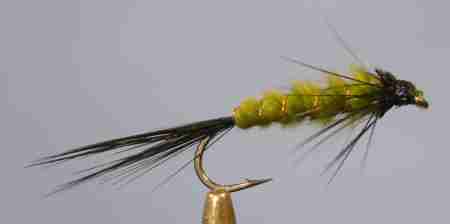
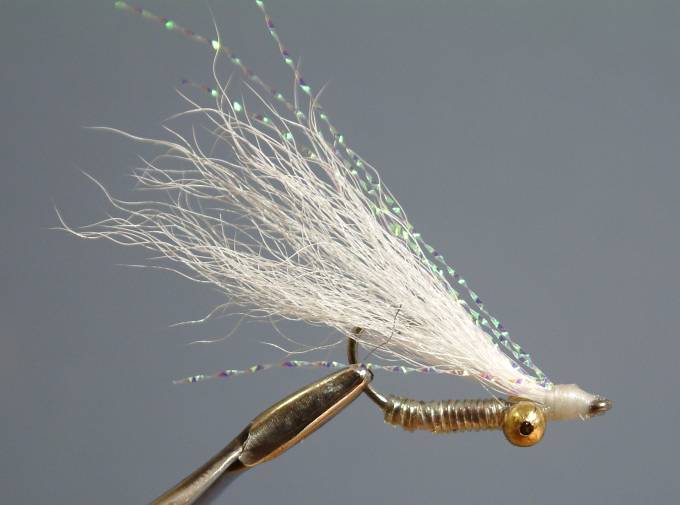

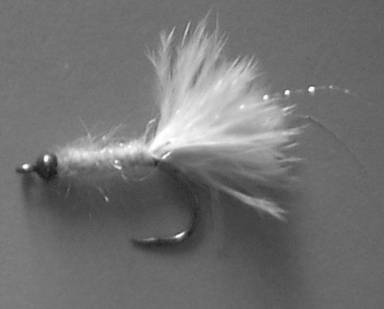
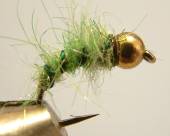
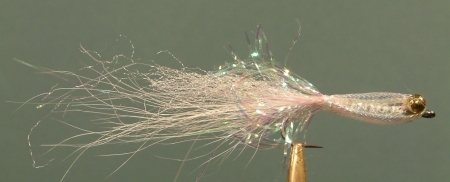
 D5 Creation
D5 Creation